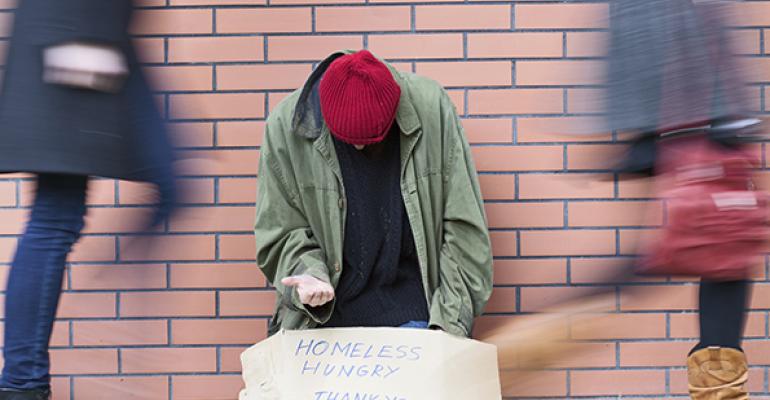Homeless families with children were turned away from emergency shelters because no beds were available in 73 percent of the cities surveyed for the U.S. Conference of Mayors' 2014 Status Report on Hunger & Homelessness Policies and Programs Addressing Homelessness.
“We have seen some extraordinary efforts by cities, private agencies, foundations, charities, and volunteers to cope with hunger and homelessness,” noted Santa Barbara, Calif., Mayor Helene Schneider. “But despite all efforts, the problems remain, as do our concerns about the future.”
Mayors across the country are building affordable housing and accessing federal resources to fight homelessness. But in many cities, the number of homeless people continues to rise overall. An average of 22 percent of the demand for emergency shelter went unmet, according to report, which surveyed the 25 cities whose mayors are members of the Conference’s Task Force on Hunger and Homelessness.
To help homeless people, these cities use Housing First and Rapid Re-housing models and funding programs like Continuum of Care and other funds from the U.S. Department of Housing and Urban Development (HUD), according to officials in 20 of the 25 cities surveyed.
The top three actions needed to reduce homelessness include more rental subsidies like federal Housing Choice Vouchers, which allow low-income people to live in mainstream rental housing, according to officials in 22 of the 25 survey cities. More permanent supportive housing for people with disabilities would also help, according to 19 of the 25 cities, while 16 of the 25 called for more or better-paying employment opportunities. Cited less frequently was more employment training programs, by 13 percent three of the cities, as well as better coordination with mental health service providers and more substance abuse services, each by two of the cities.
Support housing programs and other efforts are reducing the number of veterans in the homeless population, according to officials in 20 of the 25 survey cities. Officials in 14 cities say their experience suggests that the Veterans Administration will be able to reach its goal of eliminating veterans’ homelessness by the end of 2015. Strategies include targeted federal funds provided through programs such as HUD-VASH, the Supportive Services for Veteran Families Program, and HUD’s Continuum of Care—91 percent of the survey cities reported that their use of these funds has reduced the homeless veterans population. Nearly all of the cities, however, said more affordable housing was required to address veterans’ current unmet needs.
Another 19 cities of the 25 surveyed have adopted policies aimed at preventing homelessness among households that have lost their homes to foreclosure. That includes nine during the last year. The other 10 had adopted such policies in previous years.
Homelessness spreads
More people suffered from homelessness in the 25 cities in the survey in 2014. “We anticipated that problems related to joblessness and other lingering effects of the recession would be reflected in the reports coming in from the survey cities – and they were… despite the economic progress the nation as a whole is making,” says Schneider.
The total number of homeless persons increased by 1 percent in the survey cities. That includes an average 3 percent increase in the number of homeless families, with 43 percent of the cities reporting an increase and 22 percent saying the number stayed the same as in the previous year. The number of unaccompanied homeless individuals over the past year decreased by an average of just under 1 percent, with 35 percent of the cities reporting an increase, 26 percent saying the number stayed the same, and 39 percent reporting a decrease.
The lack of affordable housing is the single leading cause of homelessness for both singles and families, according to city officials. Unemployment, poverty, and low-paying jobs also contributed to family homelessness. Unemployment, poverty, mental illness and lack of needed services, and substance abuse and lack of needed services also contributed to homelessness for unaccompanied individuals. Across the survey cities as a group, 28 percent of homeless adults were severely mentally ill, 22 percent were physically disabled, 15 percent were victims of domestic violence, and 3 percent were HIV-positive. Eighteen percent of homeless adults were employed and 13 percent were veterans.
The 25 survey cities, whose mayors are members of The U.S. Conference of Mayors Task Force on Hunger and Homelessness, are: Asheville, N.C.; Boston, Mass.; Charleston, S.C.; Charlotte, N.C.; Chicago, Ill.; Cleveland, Ohio; Dallas, Texas; Denver, Colo.; Des Moines, IA; Los Angeles, Calif.; Louisville, Ky.; Memphis, Tenn.; Nashville, Tenn.; Norfolk, Va.; Philadelphia, Pa.; Phoenix, Ariz.; Plano, Texas; Providence, R.I.; Saint Paul, Minn.; Salt Lake City, Utah; San Antonio, Texas; San Francisco, Calif.; Santa Barbara, Calif.; Trenton, N.J.; and Washington, D.C.

